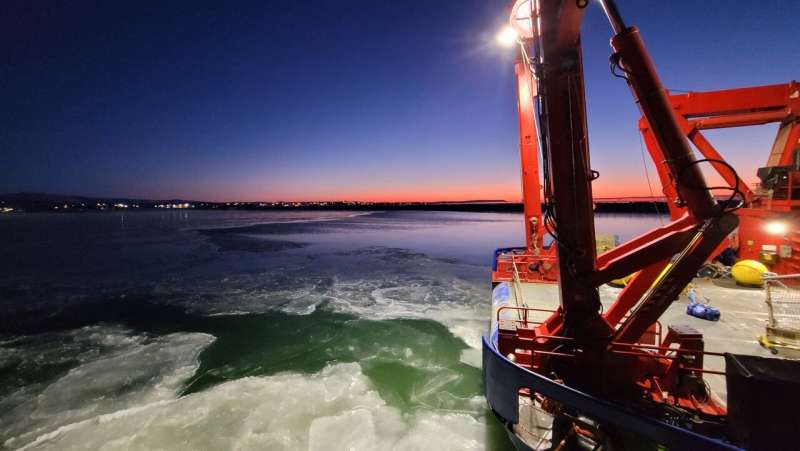This article has been reviewed according to Science X's editorial process and policies. Editors have highlighted the following attributes while ensuring the content's credibility:
fact-checked
peer-reviewed publication
trusted source
proofread
Tracking ships' icy paths amidst climate change

There has been much buzz about the warming planet's melting Arctic region opening shipping routes and lengthening travel seasons in ocean passageways that ice once blocked. Expanded fishing, trade and tourism is envisioned. The operative word here is envisioned.
Scientists at Michigan State University (MSU), University of Waterloo, and University of Alaska Fairbanks report in Climatic Change where vessels are traveling in the ice-covered waters of the Arctic between Alaska and Russia, and what those reports may mean for important wildlife and communities in the region.
"Even with climate change, sea ice is still a substantial barrier to Arctic vessel traffic," said Kelly Kapsar, a research associate at MSU's Center for Systems Integration and Sustainability (CSIS). "Sea ice also provides critical habitat for many endemic Arctic species and a hunting platform for Indigenous subsistence hunters. Understanding when and where ships are entering areas of sea ice can help us to better understand potential impacts of vessel traffic in the region."
Whether it's fishing vessels seeking better catches over a longer season, or Russian shipping companies eager for better ways to deliver oil and gas to Chinese customers, increased marine traffic is a given. Whether this traffic occurs only in the open water season, or also in times of ice cover is not.
But the researchers point out the difference between what ships could do as ice changes, and what they will do can be vastly different.
"Up until now projections have been about theoretical ships, such as noting certain vessel types can travel through up to 2 meters of ice," Kapsar said. "But that's like saying a car can drive up to 200 mph—just because it can doesn't mean it will."
Combining satellite pictures of ice cover with GPS vessel tracking data the team was able to analyze how the ships have been behaving as the shipping passages change. What they've found is that many ships are following the ice, fishing close to the edge of ice packs. The researchers also found marked overlap between areas with vessels traveling in sea ice and the overwintering areas for bowhead whales.
Previous research by another group has demonstrated that between 1990 and 2012, some 12% of bowhead whales harvested by Alaska Native subsistence hunters showed signs they had been tangled in fishing gear, and 2% had scars from being struck by vessels. The new analysis points to a growing threat to wildlife which also are using the receding ice as they travel and breed.
Noise from large boats also can disrupt marine mammals. Ships equipped to break ice potentially could strand both animals and people traveling across the frozen expanses. Increased traffic also raises fear of accidents and oil spills. The new pathways are far away from rescue or clean-up crews.
So far, Kapsar said, their work indicates ship travel reflects a certain caution, offering indications that capability is balanced by practical and economic realities. For now.
Kapsar and co-author Jianguo "Jack" Liu are members of MSU's Ecology, Evolution, and Behavior Program. "Mapping vessel traffic patterns in the ice-covered waters of the Pacific Arctic" also was written by Lawson Brigham and Grant Gunn.
More information: Kelly Kapsar et al, Mapping vessel traffic patterns in the ice-covered waters of the Pacific Arctic, Climatic Change (2023). DOI: 10.1007/s10584-023-03568-3
Journal information: Climatic Change
Provided by Michigan State University





















